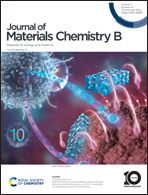Catalytically proficient ceria nanodots supported on redox-active mesoporous hosts for treatment of inflammatory bowel disease via efficient ROS scavenging†
Abstract
Ceria nanozyme-based ROS scavengers have shown great potential in the treatment of inflammatory bowel disease (IBD) through microenvironment regulation. However, the currently developed nanotherapeutics suffer from difficulties in concomitantly achieving small sizes and stable interparticle dispersion which is pivotal to sufficient oxygen vacancies facilitating electron transfer and oxygen storage in the dynamic cycling of Ce3+/Ce4+ redox pairs. Herein, a hybrid nanosystem consisting of ceria nanodots supported on redox-active mesoporous hosts was developed to address the challenge of ROS scavenging, in particular the efficient downregulation of the readily renewable, highly concentrated H2O2 species. Specifically, Ce4+ ions oxidized from Ce3+ in weakly basic solution were captured and reduced in time by the abundant catechols on the mesoporous polydopamine nanoparticles. This led to strong restriction of ceria growth (∼2.8 nm) in the ion precipitation process and efficient maintenance of the Ce3+/Ce4+ ratio at a high value of 1.59 which is 4.8 fold higher than that of homogeneously nucleated ceria nanoparticles. Through this design, the nanohybrid showed an attractive catalytic performance in scavenging multiple ROS species, particularly the fast and recyclable conversion of H2O2. Thereby, significant suppression of the inflammatory cytokine/chemokine secretion was achieved by inhibiting the activation of NF-κB signaling pathways (5.1 fold higher as compared to those of pristine ceria nanoparticles), upregulating the Nrf2 signaling pathway, and reducing the proportion of M1 macrophages at IBD sites. Therapeutic efficiency was also demonstrated by the effective repair of the intestinal mucosal barrier by recovering the tight junction integrity in vivo. This study sheds light on the employment of redox-active hosts to support ceria catalysts for advancing anti-inflammation applications by boosting ROS scavenging performance.



 Please wait while we load your content...
Please wait while we load your content...